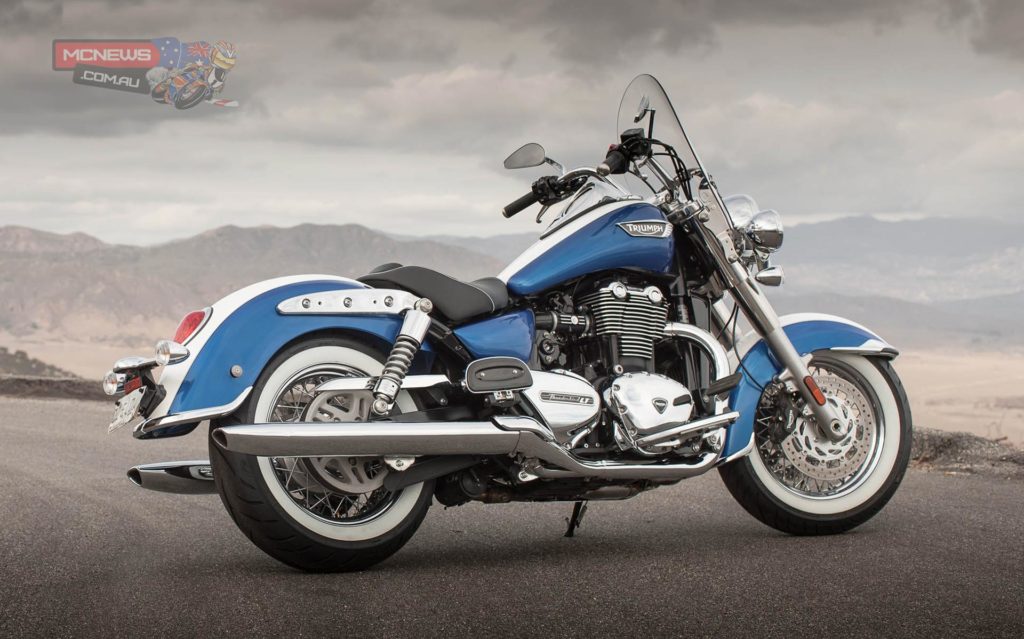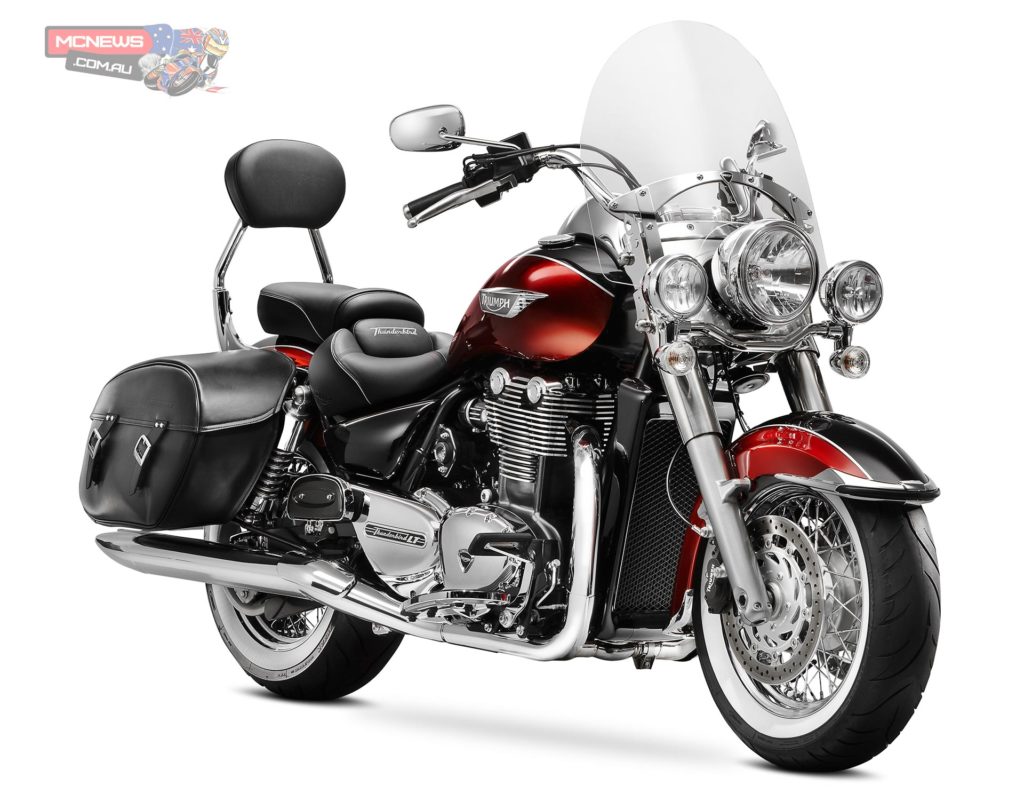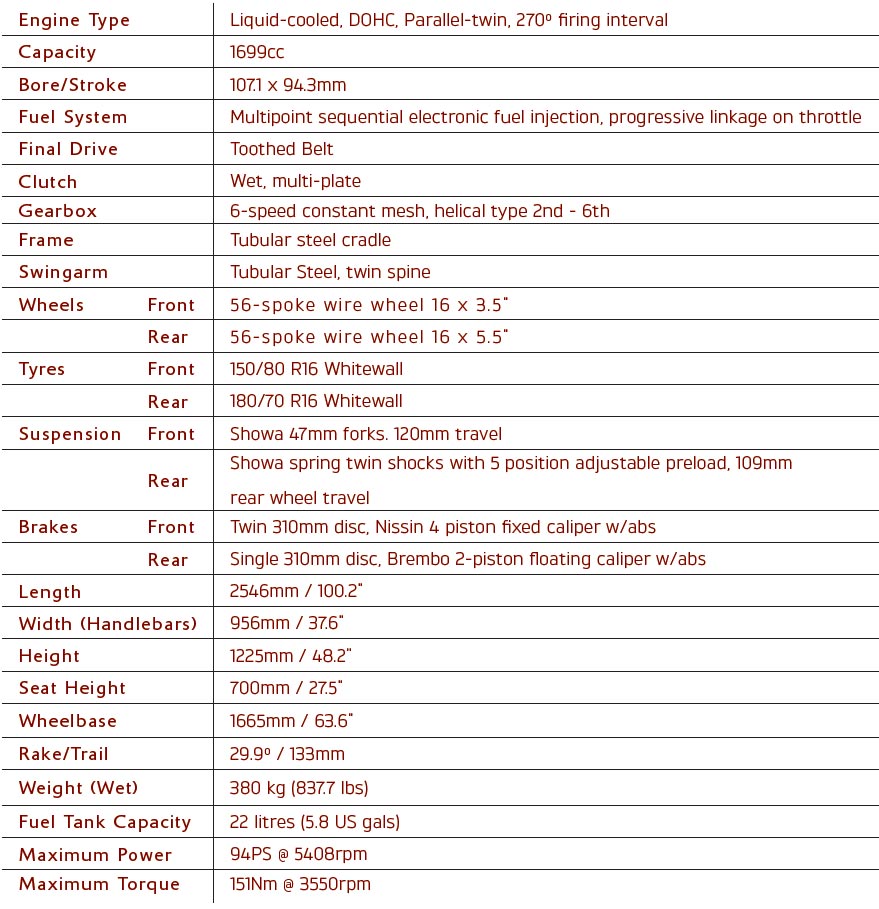Words By Trevor Hedge
Most riders would assume that Triumph’s biggest selling models are sporty machines such as the Street or Speed Triple, the spritely Daytona 675R sports bike, or perhaps the popular new Tiger 800XC? In fact Triumph’s big Thunderbird Storm Cruiser is the British brand’s highest selling model in Australia. This result underlines just how strong the cruiser market is Down Under. In fact, according to market figures Australia is the second strongest cruiser market in the world behind the USA. Thus, the arrival of the new Thunderbird LT, is clearly big news.
And the LT is big! Boasting the largest parallel twin in the world and tipping the scales at 380kg, it’s a monster of a motorcycle. LT stands for ‘Light Touring’, with the ‘Light’ obviously not referring to weight, but indicating that while the Thunderbird LT is indeed a ‘bagger’, it’s not a full dress touring machine. When it comes to touring however the LT, with its standard luggage and best in class seat, is an infinitely more practical and comfortable choice than most cruiser machines.
Thanks to easily removable leather bags and screen the LT also cuts a very fine figure in the city. In fact, when the separate pillion seat is left at home, along with the bags and screen, it is actually a quite beautiful motorcycle. Particularly in the Caspian Blue / Crystal White colour combination, which works particularly well with the bold whitewall radial tyres, spoked rims and slashes of chrome. With only a huge single cylinder visible from each side of the machine the Thunderbird also marks quite a visual departure from the de-riguer big v-twin that is the norm for the class. This immediately makes the Triumph stand out as a little bit different, it looks solid and it works.
At 1699cc and sporting huge 107mm pistons the Triumph does however have a nice bit of thump to it, aided by its 270-degree firing order and off-set crank pins. However, it doesn’t exhibit quite the same degree of theatre that a big twin enjoys. Perhaps that is emphasised by the fact that the Triumph engine is so well polished and simply goes about business without fuss, but with 93hp at 5400rpm and 151Nm of torque at 3550rpm it does carry a fairly big stick. A conventional throttle cable instead of ride by wire to control the pair of 46mm Mikuni throttle bodies means that there is no cruise control on the Thunderbird, but throttle response and fuelling is hard to fault. The only real criticism I can make is that on a hot day heading back into Melbourne the big twin radiated a very uncomfortable amount of heat when waiting at traffic lights.
The lack of the need for separate primary and secondary drives thanks to the integrated helical cut six-speed gearbox also helps to reduce mechanical noise. The gearbox and clutch work well and drive is transferred to the sensibly sized 180/70-16 rear tyre via a toothed belt, the latter a choice dictated by market research rather than engineering concerns.
Thankfully, Triumph did allow engineers to dictate function over fashion when it came to tyre sizes, the LT’s comparatively narrow tyre package and 56-spoke rims helping to endow the machine with surprising nimbleness. Eager riding quickly touches down the floorboards but fairly rapid progress can be made while keeping the undercarriage off the deck when a more sympathetic riding style is employed. Stability is good, steering effort reasonable.
A trio of 310mm discs are fitted, the pair up front clamped by Nissin four-piston calipers, the rear a single-piston Brembo, all of which are supplied their fluid via braided lines. At first I thought the brakes required a little too much effort but as the kilometres rolled on they got much better as they bedded in. Chrome shrouds surround the 47mm Showa forks that dealt well with our simulated emergency stops, where the LT also demonstrated a well tuned ABS system that does not intervene too early.
Comfort is an area where Triumph have put in plenty of work. A full 95mm of high-density, dual-layer seat foam is well shaped and supported by a smartly positioned lumbar support pad. The seat cover is made from a special material that while helping to hold the shape of the seat also offers some elasticity which helps reduce any pressure spots. Sure, most of that preamble is from the press pack, but my bum thought the Triumph perch just wonderful, ranking it as one of the best seats in motorcycling. Clearly a lot of work went in to this area and it has paid dividends. The generous, for a cruiser, 109mm of rear suspension travel, dual-rate springs and five-way preload adjustable Showa shocks help things further. It takes a really big hit for the rider to cop an uncomfortable blow and the springs are designed to cope with the additional load of luggage without getting out of their comfort zone. We didn’t sample the separate pillion seat but Triumph’s guff suggests that it sports the same construction methods as the rider’s, so it should be good. The optional backrest would help to keep your pillion happy.
At 700mm the seat makes climbing on or off the LT a simple affair. It also helps with any tricky car park manoeuvres and the LT is never too imposing when things get sketchy. The switchgear is fine and the foot controls include a heel-toe shifter. Personally, I can’t stand highway pegs but for those that love them Triumph has fitted them as standard. At least the Triumph seat is good enough to cope with the coccyx loads that riding with your feet on highway pegs imposes on your lower regions. The regular footboards work just fine and are at a natural angle,
Outside of the traditional Bonneville and Thruxton machines I can’t say I have ever found Triumph’s fonts and design work on their instrumentation and binnacles at all aesthetically agreeable. Unfortunately, for me, the Thunderbird LT also goes in the same boat with the speedo graduations and Thunderbird logo looking pretty naff, despite its heritage value. It all functions pretty well though and includes a clear easy to read conventional fuel gauge alongside a handy LCD which includes a variety of trip computer functions that can be cycled through via the handlebar switchgear. It also helps that the instrument binnacle is raised at an angle on the top of the 22-litre fuel tank that doesn’t require the rider to completely take their eyes off the road in order to view it. The mirrors are great and vibration free.
Our test machines were fitted with the optional ‘Quantum Coated Touring Screen Blade’. While we have no idea what Quantum coated means we can tell you that the Touring Screen is 165mm wider than the standard offering and is remarkably stiff with no flex visible at any speed. I am not in a position to rate the standard screen, which is a smaller look over affair, but I can tell you this $275 optional screen is bloody awesome. The screen is also beautifully simple to remove or install on the machine in a matter of seconds. It just simply pops on and off a set of attractively finished turned steel mounting bobbins. Our bikes also scored the optional polycarbonate lower air deflectors which mount directly to the screen and command a reasonable $175 premium. The generously sized 28-litre saddlebags are not quite as simple to remove and do require tools but again this is only a five minute job at worst, and along with the removal of the pillion seat does wonders for the machines aesthetic appeal.
The Thunderbird LT really does boast seriously impressive touring credentials and is a very well rounded, and finished, package that at $23,490 (plus on roads) stands out as perhaps the best value cruiser offering in the marketplace.

Positives
- Good value for money
- Excellent comfort
- Class leading performance
- Useful standard luggage and appointments
- Versatility – Stripped down cruiser or bagger tourer all in the one bike
Negatives
- Engine radiated plenty of heat in traffic
- No cruise control
- Not the same degree of theatre as a v-twin offers
























